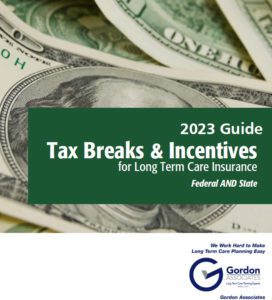There are two main types of Long Term Care Insurance, offering consumers more choices than ever.
Gordon Associates offers both types of Long Term Care Insurance. They’re described briefly below
Stand-alone Long Term Care Insurance Policies
Also known as Traditional Long Term Care Insurance (LTCI), Stand-alone LTCI policies offer the most direct, affordable solution for paying for long term care expenses. These policies have been available for over 40 years. Most policies reimburse the actual cost of care (up to your policy limits) if:
- You require assistance with at least two of six activities of daily living: dressing, bathing, feeding, toileting, transferring and continence
- You become cognitively impaired, for example, because of Alzheimer’s Disease.
Stand-alone Long Term Care Insurance Policies include these components:
- How much coverage you’ll get per month (“monthly benefit”) – benefits range from $1,500 to $12,000 per month, depending on the insurance company
- How long you’ll get benefits (“benefit period”) – benefit periods range from 2 – 6 years, also depending on the insurance company.
- How long before your monthly coverage starts (“elimination period”) – this can range from 0 days up to 365 days
- Optional benefits – you can add on optional benefits (“riders”). One we recommend you consider is an inflation protection rider. This rider increases your monthly benefit over time to keep up with increases in cost of living.
See our section on individual long term care insurance policies for more information
Hybrid Long Term Care Insurance Plans
A hybrid long term care insurance plan (aka “Asset-based Long Term Care Insurance”) combines two types of coverage under one policy– either life insurance or an qualifying annuity with a Long Term Care Insurance rider. If you already have a permanent life insurance policy or an annuity, they can be re-purposed to add an LTCI rider. The rider will include the same basic components of stand-alone plans as described above. Hybrid plans haven’t been offered for as long as stand-alone plans, but they’re growing rapidly in popularity.
Asset-based Long Term Care Insurance plans only work for people who have assets to reallocate
An asset-based LTCI plan offers you a number of advantages, including:
- One policy, two purposes – now the total value of the policy goes to both long term care insurance or life insurance/annuity. For example, if you had a hybrid plan with a total benefit for $500,000 and used $200,000 toward long term care coverage, the remaining $300,000 would be paid as a death benefit just like any other permanent life insurance would
- Your premiums are guaranteed not to increase
- Flexibility in payment – you can choose to pay your premiums in a lump sum (“single pay plan”), 20 annual payments (“20 pay plan”), or lifetime payments.
- Underwriting is less stringent
- Re-purposing is tax free – if you already have a permanent life insurance policy or qualifying annuity, you can use a 1035 exchange.
- Get a refund of premiums – with many plans you can cash in your policy for any reason and get back some or all of the premiums you’ve paid in.
If you are interested in learning more about stand-alone traditional or hybrid asset-based Long Term Care Insurance plans, we are happy to help. Please contact us.

 To help determine if long-term care (LTC) insurance is right for you, we are offering a FREE informational guide. This is a comprehensive booklet that will answer many of your questions about tax breaks and incentives for LTCI for federal and state taxes.
To help determine if long-term care (LTC) insurance is right for you, we are offering a FREE informational guide. This is a comprehensive booklet that will answer many of your questions about tax breaks and incentives for LTCI for federal and state taxes. To help determine if long-term care (LTC) insurance is right for you, we are offering a FREE informational guide. This is a comprehensive booklet that will answer many of your questions about LTC and assist you with your health care planning.
To help determine if long-term care (LTC) insurance is right for you, we are offering a FREE informational guide. This is a comprehensive booklet that will answer many of your questions about LTC and assist you with your health care planning.